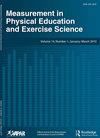Agreement of a Portable Motion Capture System to Analyze Movement Skills in Children
IF 1.9
4区 教育学
Q2 EDUCATION & EDUCATIONAL RESEARCH
Measurement in Physical Education and Exercise Science
Pub Date : 2022-06-15
DOI:10.1080/1091367X.2022.2088290
引用次数: 0
Abstract
ABSTRACT This study evaluated the agreement between Kinect V2 with AssessLink and Vicon motion capture systems in children performing the vertical jump (JL) and forward leap (Leap). Eighteen healthy children (5–17 years) performed the movements while recorded simultaneously by both motion capture systems. Spearman correlation (ρ) and Bland-Altman were used to determine joint angle agreement. Overall, agreement varied by body segment, movement type, and phase. JL for knees and shoulder ranged from ρ = −.220 to .543; bias = 8.1 to 23.0° and ρ = −.743 to .410; bias = 8.1 to 56.5°, respectively. Leap had poorer correlation and bias for the appendicular segments (ρ = −.091 to .306; bias = −47.5 to 73.7°) than axial segments (ρ = .345 to .553; bias = 11.3 to 22.9°). The Kinect V2 should not replace criterion kinematic systems, but may improve gross motor assessment methods when selecting for specific movement observations.便携式运动捕捉系统用于分析儿童运动技能的协议
本研究评估了搭载了AssessLink和Vicon动作捕捉系统的Kinect V2在儿童进行垂直跳跃(JL)和向前跳跃(leap)时的一致性。18名健康儿童(5-17岁)在两种动作捕捉系统同时记录下这些动作。Spearman相关(ρ)和Bland-Altman用于确定关节角度一致性。总体而言,这种一致性因身体部位、运动类型和阶段而异。膝关节和肩部的JL ρ =−。220至0.543;偏差= 8.1至23.0°,ρ =−。743至0.410;偏差分别为8.1 ~ 56.5°。Leap对阑尾节段的相关性和偏倚较差(ρ =−)。0.91 ~ 0.306;偏置= - 47.5至73.7°)比轴向段(ρ = .345至.553;偏置= 11.3 ~ 22.9°)。Kinect V2不应该取代标准的运动学系统,但可以在选择特定运动观察时改进大肌肉运动评估方法。
本文章由计算机程序翻译,如有差异,请以英文原文为准。
求助全文
约1分钟内获得全文
求助全文
来源期刊

Measurement in Physical Education and Exercise Science
Medicine-Orthopedics and Sports Medicine
CiteScore
4.20
自引率
33.30%
发文量
24
期刊介绍:
The scope of Measurement in Physical Education and Exercise Science (MPEES) covers original measurement research, special issues, and tutorials within six substantive disciplines of physical education and exercise science. Six of the seven sections of MPEES define the substantive disciplines within the purview of the original research to be published in the journal: Exercise Science, Physical Activity, Physical Education Pedagogy, Psychology, Research Methodology and Statistics, and Sport Management and Administration. The seventh section of MPEES, Tutorial and Teacher’s Toolbox, serves to provide an outlet for review and/or didactic manuscripts to be published in the journal. Special issues provide an avenue for a coherent set of manuscripts (e.g., four to five) to collectively focus in-depth on an important and timely measurement-related issue within the scope of MPEES. The primary aim of MPEES is to publish high-impact manuscripts, most of which will focus on original research, that fit within the scope of the journal.
 求助内容:
求助内容: 应助结果提醒方式:
应助结果提醒方式:


